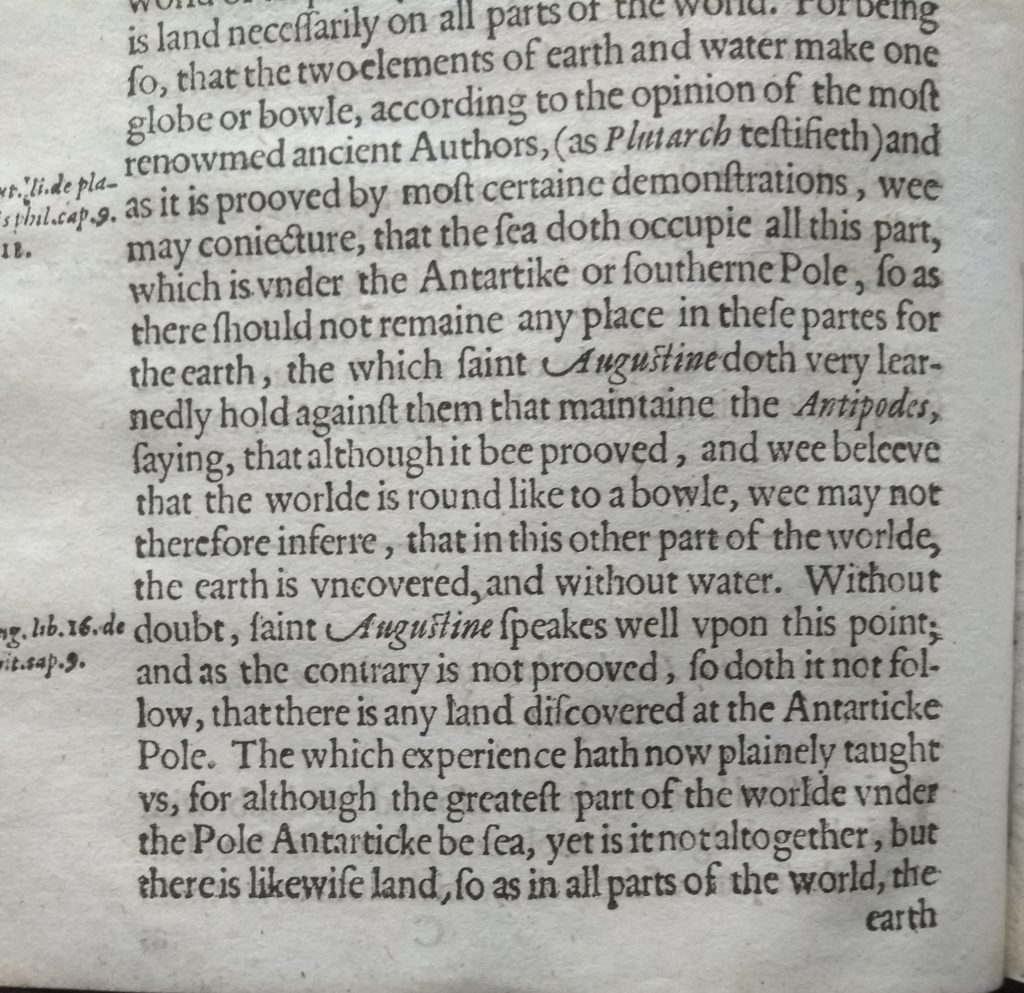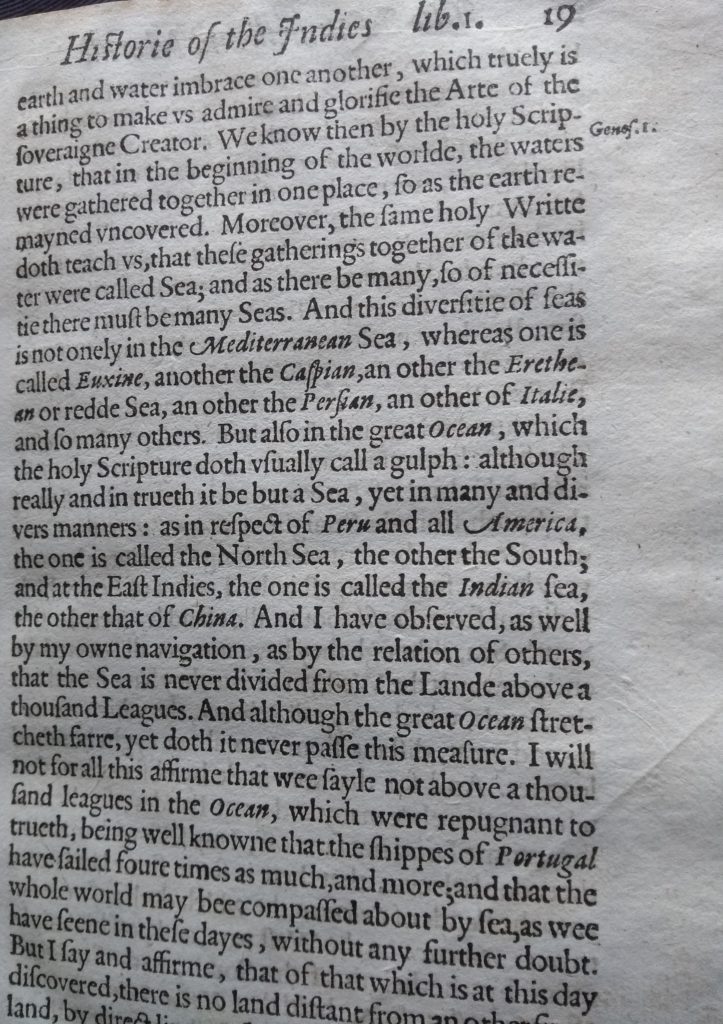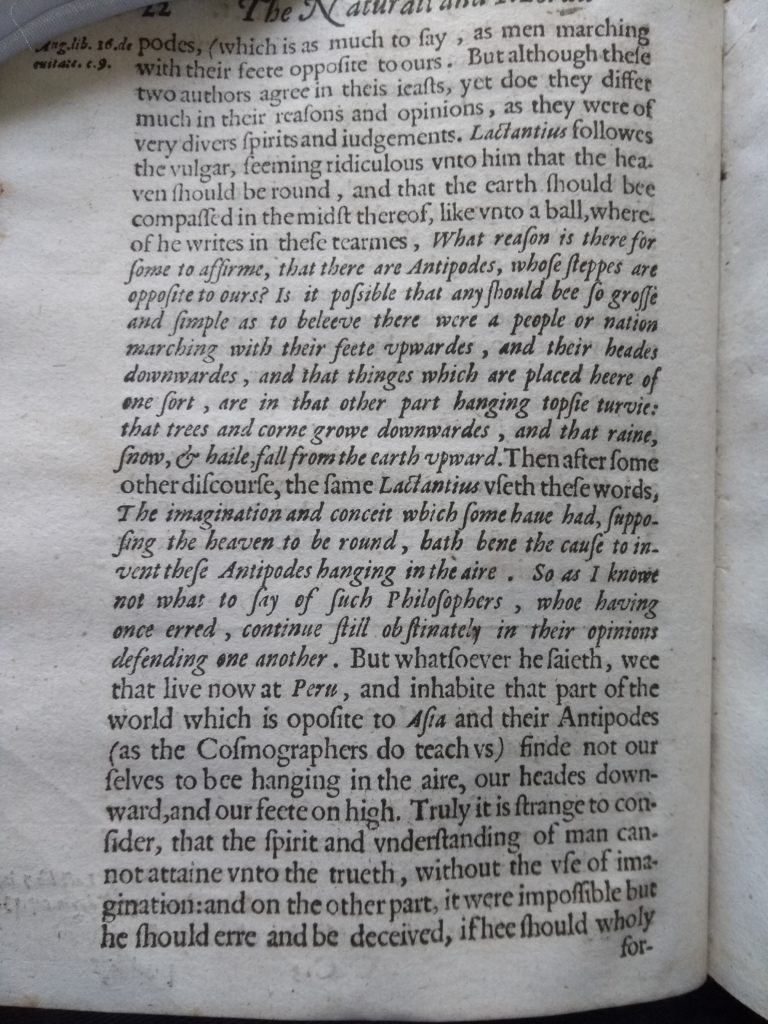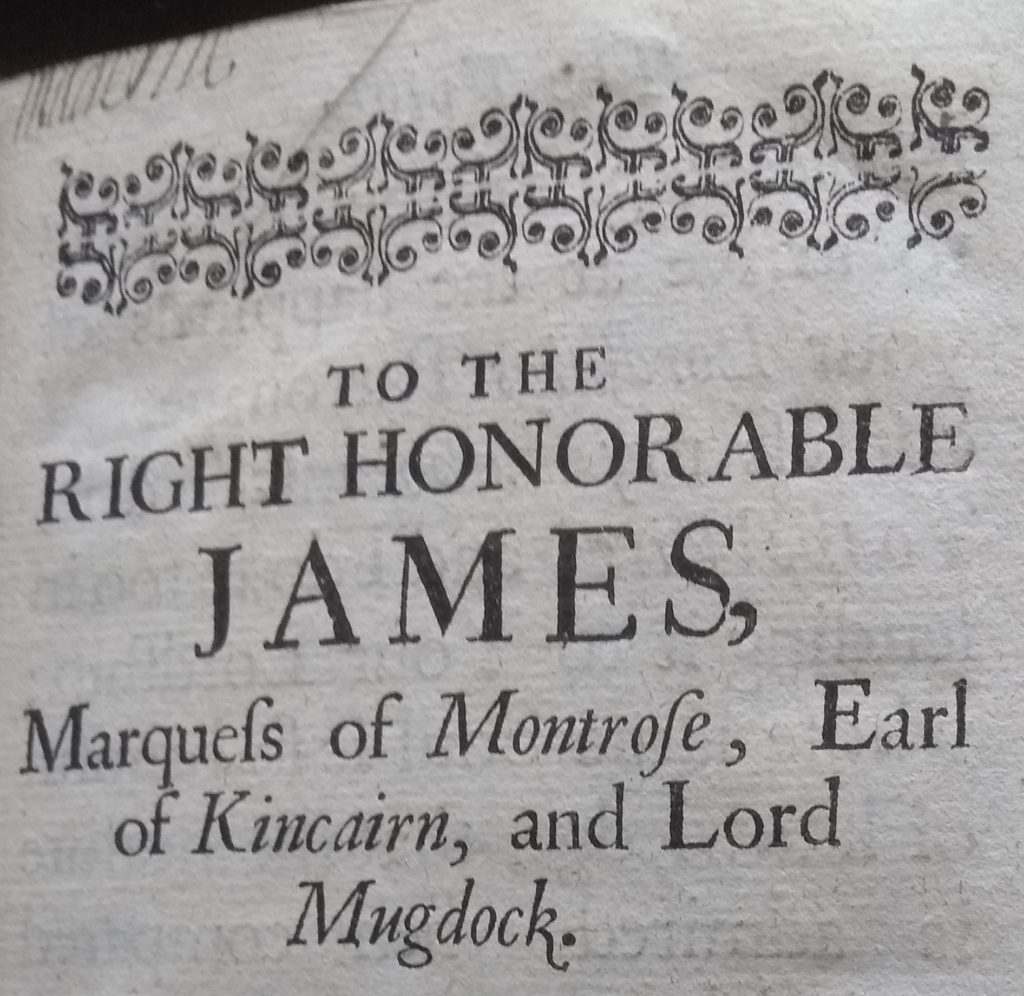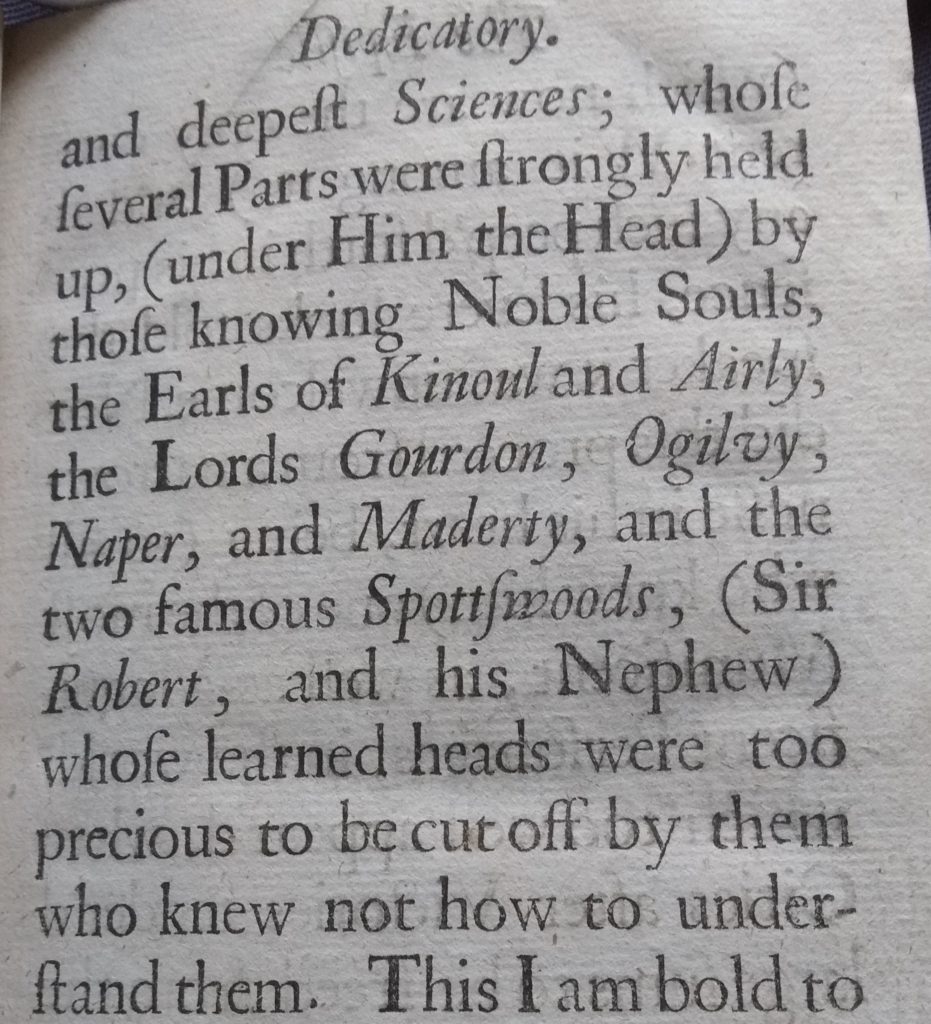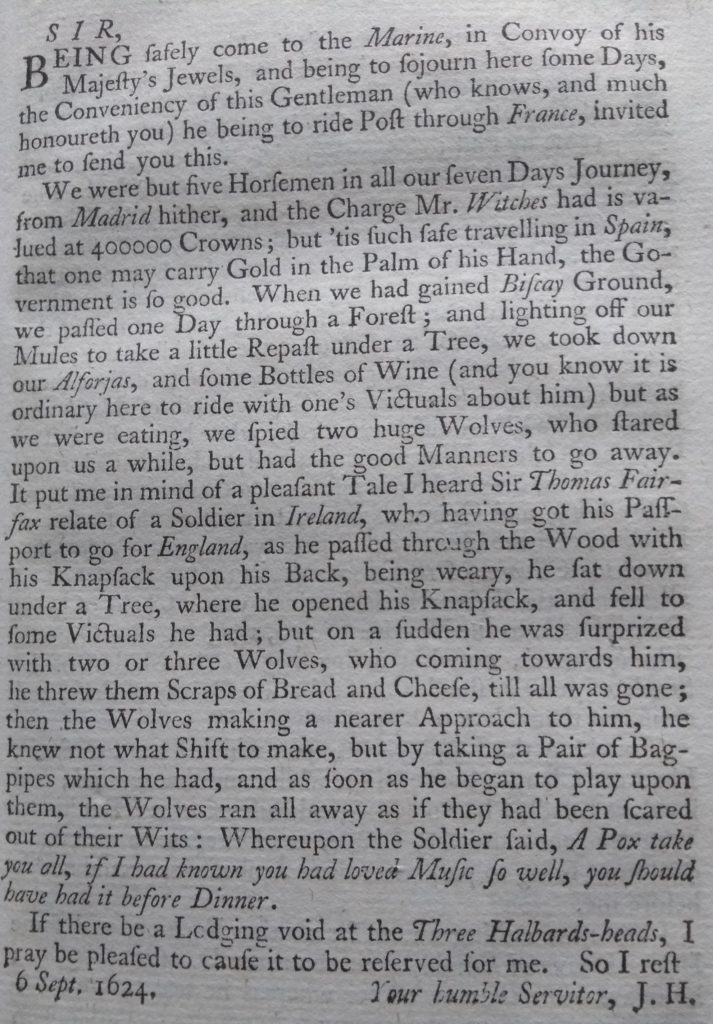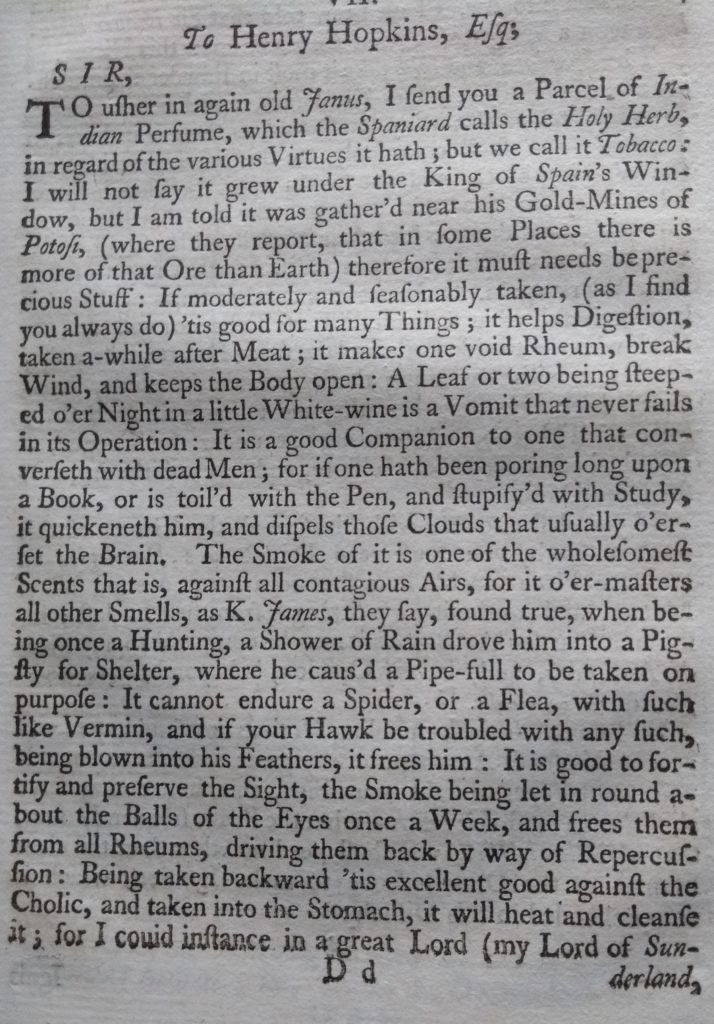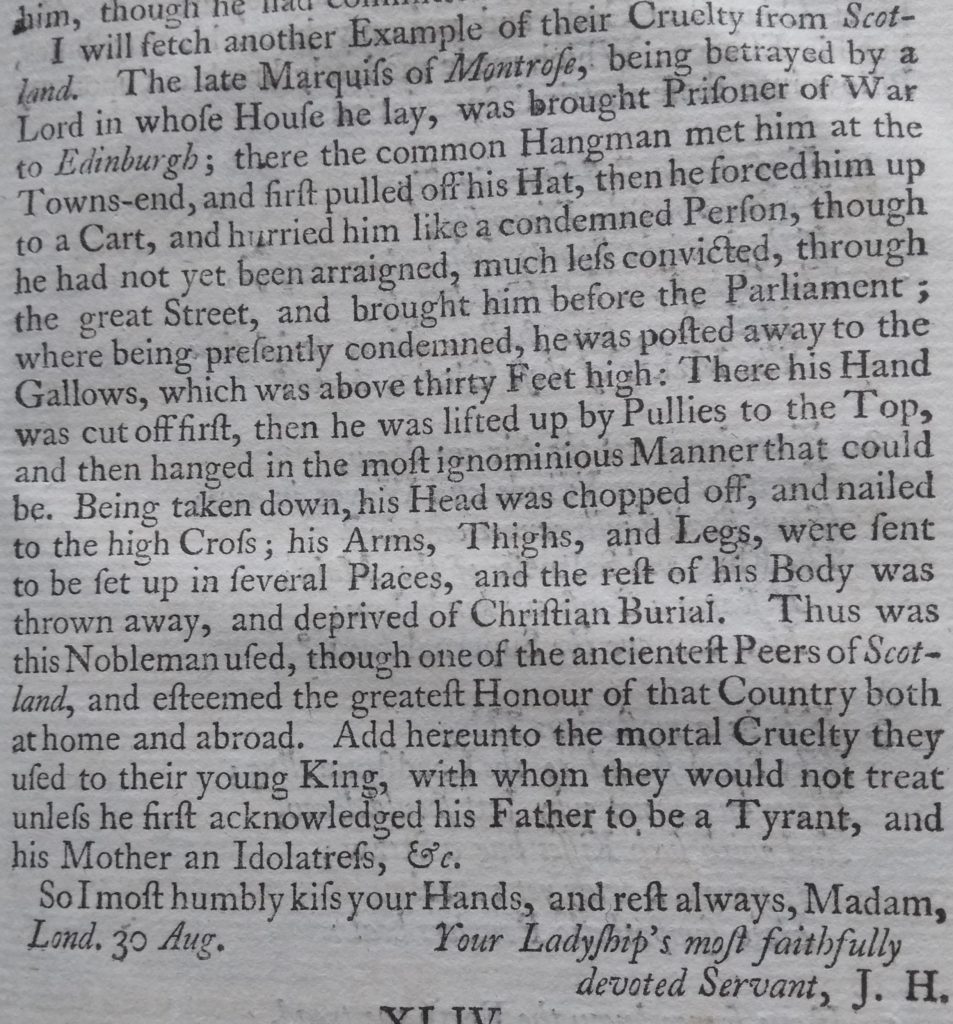Welcome to the fifth in this series of blogs that have been appearing every now and then to pique the interest of the wonderful followers of the life of Innerpeffray Library. As always, the theme is a general one, but I try to ensure that there is a variety of books, so hopefully there is something for everyone. For those of you lucky enough to have visited the Library, you will have noticed that the shelves really do go from floor to ceiling and, as a result, there are some shelves that really do not get the attention that they perhaps deserve. This series aims to remedy this injustice by dragging out the ladder and going for a quick Tour of the Tops to see what gems there are awaiting true recognition! This ‘Episode’ looks at some rather exotic food, a rather misleading (to 21st century eyes at least!) essay on tobacco and that rare find – a 17th century book that actually mentions the Library’s founder!
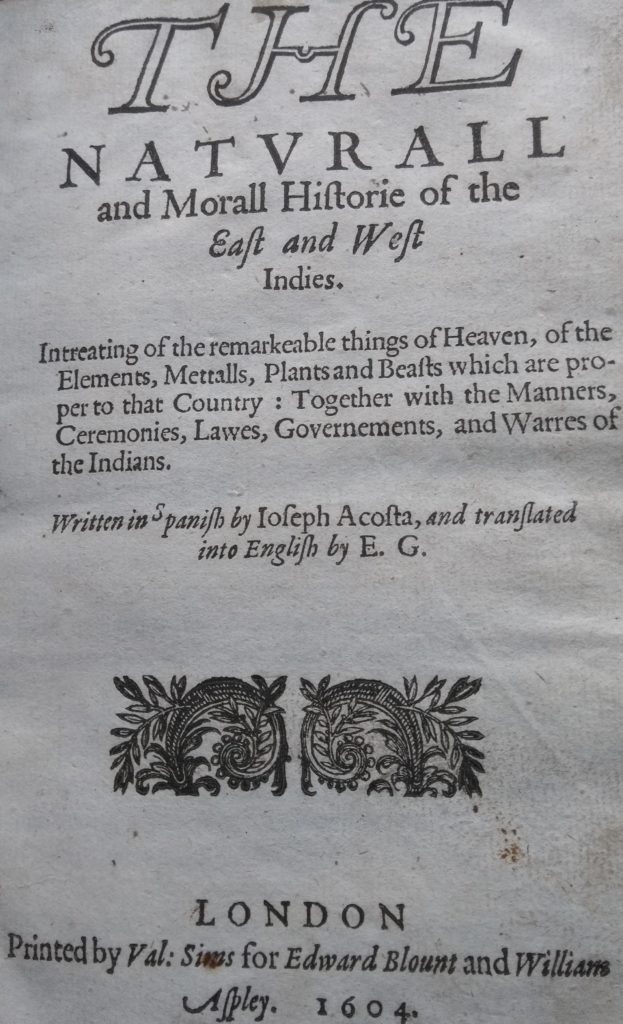
The first book I want to share with you today is all about the East and West Indies. The book is a translation of José de Acosta’s work describing the New World in great detail. Acosta was a Spanish Jesuit missionary who spent a significant amount of time in South America and was one of the first Europeans to describe altitude sickness and to attribute it to the thinness of the air. Given this was two centuries before oxygen was discovered, he was quite far ahead of his time! Fortunately for us, the Library’s copy is indeed a translation, so I was able to read it without too much difficulty! It’s very much the kind of book that you could read cover to cover given the time, but I decided to focus on two specific aspects. One thing to note, as you may have perhaps already guessed, is that the book’s focus is on what we now call South America, and there is not so much on the East and West Indies. I wonder if this is a slight mistranslation of Historia natural y moral de las Indias, the original Spanish title and someone assumed that the plural was because it covered both East and West Indies? Either way, don’t expect much about the Philippines or Jamaica in the book!
So having just said that the book is primarily concerned with South America, I am now going to seemingly contradict myself, as the first thing I want to share is all about… the Poles. No, not the inhabitants of Poland, but the antipodean regions of the globe. There is a rather fascinating description of the form of the world and the inhabitants thereof, as you can see in the pictures below (nothing that the third is not the page immediately after the second!)
Quite a lot of text to digest there, apologies! Starting on the left, we have a description of the world, although not quite as we understand it! I’m sure none of my readers still cling to the myth that Colombus believed the world was flat when he set sail for China, but there have been various historical figures that believed the world is flat, or bowl-shaped (with slightly concave sides), or even floating in water in an endless ocean. It is the latter theory upon which this text touches in the first and second photos, but concluding that “the Sea is never divided from the Lande above a thousand Leagues.” (approximately 3000 miles). It’s an interesting idea that the antipodean point on the earth to land is water and vice versa, although our more enlightened times have comprehensively shown otherwise! Continuing across to the third sheet, we find Acosta quoting heavily from a late Roman author called Lactantius. This chap was not a fan of the round earth theory and dismisses it in quite ridiculous ways. “Is it possible that any should be so grosse and simple as to beleeve there were a people or nation marching with their feete upwardes, and their heades downwardes”? When you think that this is being written without any understanding of gravitational forces, you can kinda of understand where he is coming from, however insane it sounds to us today. Imagine a ball with a figure standing at the top; if you try and place someone on the opposite side, of course their feet are now at the top and things fall from where their feet are towards where their head is. Logical, isn’t it? I do love Acosta’s rebuttal to the idea – a simple and clear demonstration of the inaccuracy of Lactantius’ theory! “Wee that live now at Peru… finde not ourselves to bee hanging in the air, our heades downward, and our feete on high”.
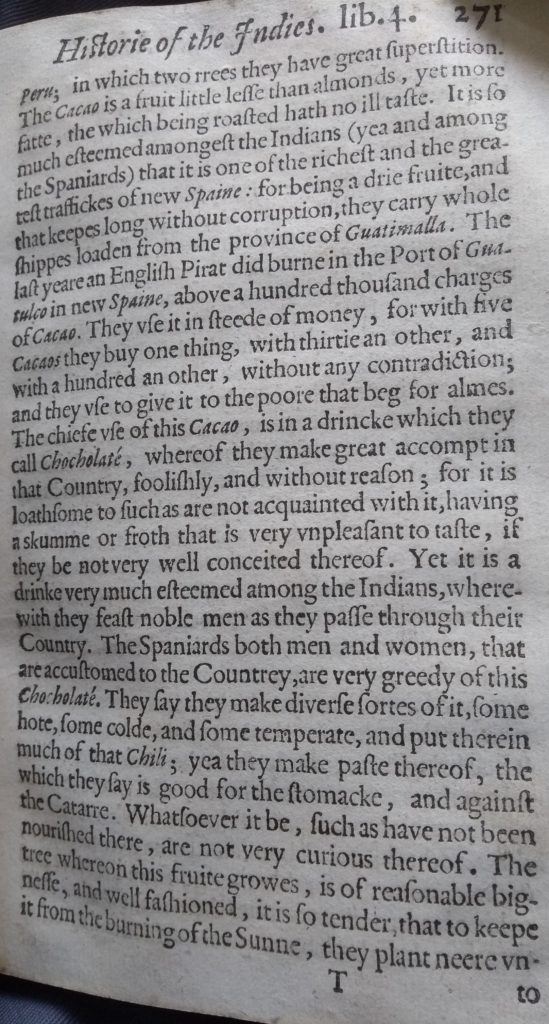
The other thing I wanted to share, as mentioned in the introduction, was some rather interesting food-related information from the New World! On the left you can read about the “Cacao” – source, of course, of chocolate in our modern lives. However, chocolate as we know and love it today was not something that was available at the end of the 16th Century, and so it has a rather different form. As can be seen, the main use is for a drink called “Chocholaté” (looks familiar!) that is “loathsome to such as are not acquainted with it, having a skumme or froth that is very unpleasant to taste”. Hmm, now sounds less familiar! It gets even better as we read on – “They say they make diverse sortes of it, some hote, some colde, and some temperate, and put therein much of that Chili” Wait, WHAT do they put in?! Having once tried a modern attempt at recreating this “chocholaté”, I have to say it is not something I can recommend… Maybe it’s something that you have to get used to over time – or perhaps my tastes are just cultured enough to enjoy it; after all, “they feast noble men as they passe through their Country” with it!
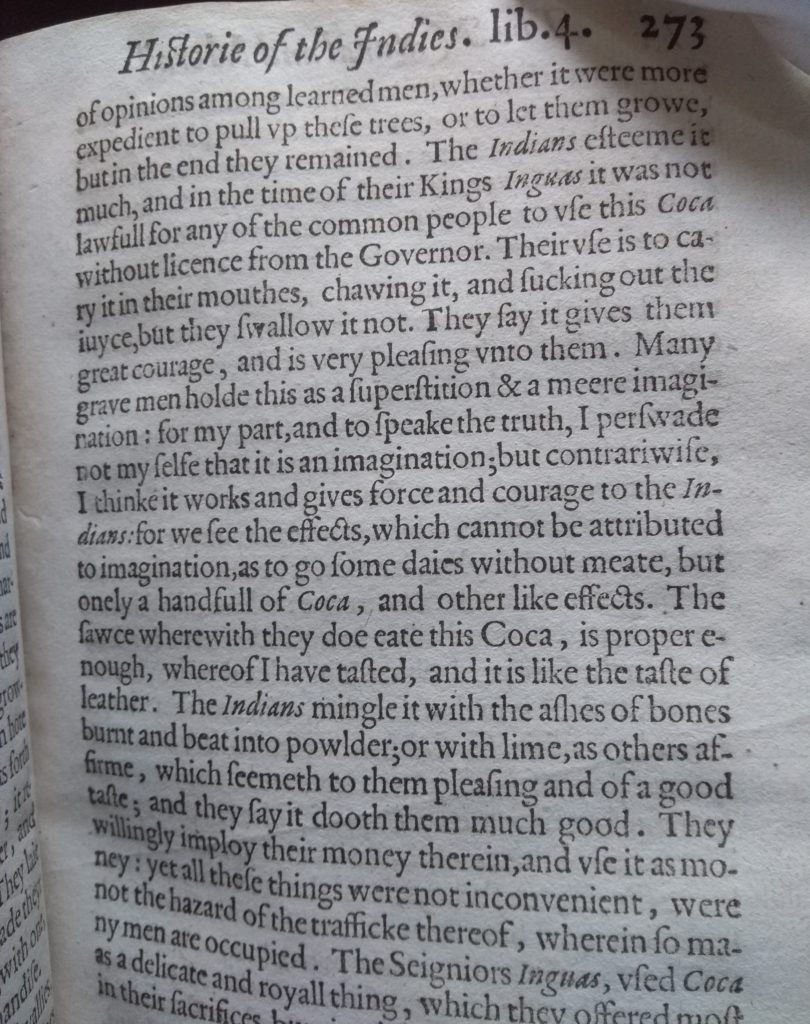
So one final treat from this book before I move on… A substance that is a little less acceptable than chocolate in today’s society! Coca leaves – the source of cocaine. Here we get a description of the practice of chewing the leaves for a mild dose of the cocaine (not that this was known to Acosta at the time of course). Acosta describes the coca as being “like the taste of leather” – hardly a ringing endorsement – but he seems confident in its abilities. One wonders how much he tried. I will leave you with the delightful way that it could be eaten as well as chewed – “mingle it with the ashes of bones burnt and beat in powlder; or with lime”. Given some of the things that allegedly get mixed in with modern cocaine, this sounds worryingly familiar! A most fascinating read indeed, and a book I could certainly recommend to any Library visitor!
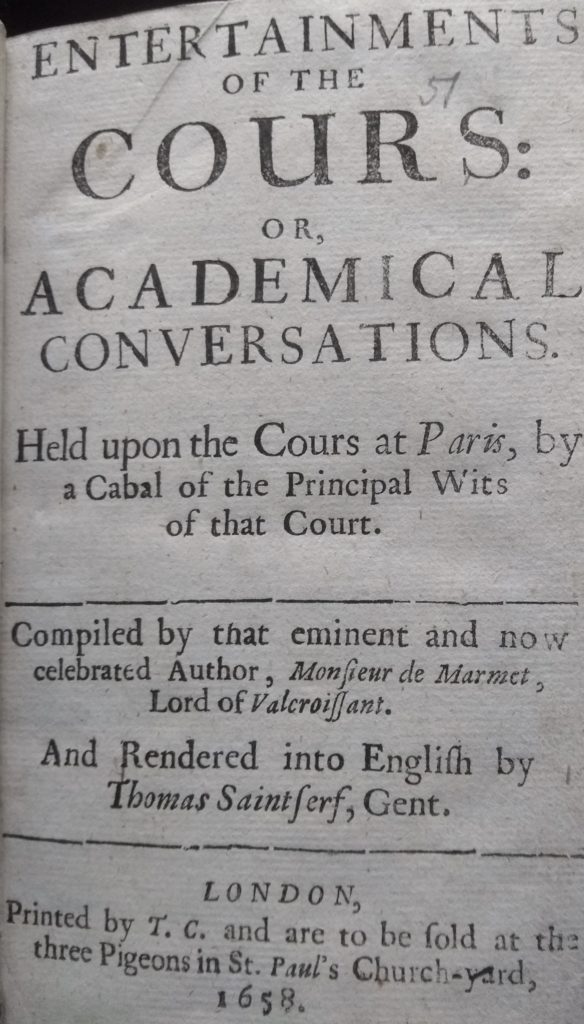
The next book on today’s Tour is another Madertie book. If I’ve learned one thing from doing these tours thus far, it’s that Madertie had excellent taste because there are a lot of fascinating books from his collection to enjoy! This one is the “Entertainments of the Cours”, written (unsurprisingly) in French originally and “rendered” into English. As a Francophile, I am always drawn to books about 17th Century France, especially as this promised to discuss life in the early years of the Sun King Louis XIV. What really surprised me, however, was on the next page…
So I first saw, just in the top left corner of the left-hand image, Madertie’s signature, but then, well hello!! I spy a Marquis (or Marques as the printed text claims) whom I recognise! A quick reference back to the date on the frontispiece confirms that this is the second Marquis of Montrose, not his most renowned father who had died in 1650, and therefore this is the nephew of Madertie, as his wife was the sister of the first Marquis. Even with this, I was far from ready for what I found on the next page… A reference to Madertie himself (here spelled Maderty)! I was absolutely stunned; I’ve seen his signature so many times in various books around the Library, as well as his name in print in our various leaflets and signs and whatnot, but here we have a contemporary writing about him! For a man about whom we know almost nothing, this is a huge deal. Yes, sure, it’s a fleeting reference, merely saying that he is a “Noble Soul” known by the first Marquis of Montrose, but it is a reference nonetheless. The dedication is from the English translator, but what I find fascinating is the fact that this was published in 1658, under the Cromwellian Commonwealth, yet it praises people who had fought against and been executed by that regime! One wonders how they got away with this at the time! It’s not as if the printing was done abroad and the book smuggled into the country; it was sold at the “three Pigeons in St. Paul’s Churchyard” – a common location for booksellers. So here we have a book that Madertie owned and could read his name in print; what else does it have to show us?
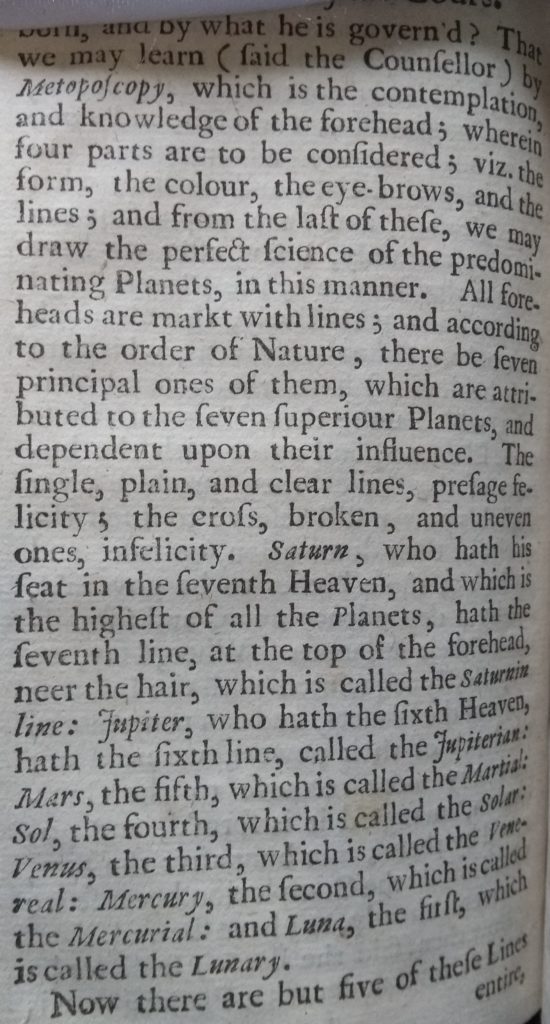
After some meandering through the text, I came across this wonderful section on Metoposcopy. “What is Metoposcopy” I hear you cry? Well, do see this wonderful blog post from Dr. James Grant which talks about it. To summarise briefly, it was the ‘science’ of assessing a person’s future by the lines on their forehead in relation to the planets. It was quite in vogue during the late 16th and 17th Centuries and there were a lot of books published on the subject. Clearly it was discussed at the French Court during that period, despite a ban on the practice by Pope Sixtus V. As you can tell from the text, each line on your forehead corresponds to a planet (or other celestial body) and through this, the expert metoposcist could tell all sorts of secrets about your life. Quite the bizarre practise – your future would have been literally written on your face! It does sound like the kind of thing that foppish courtiers, well isolated from the realities of the world, would have found utterly fascinating!
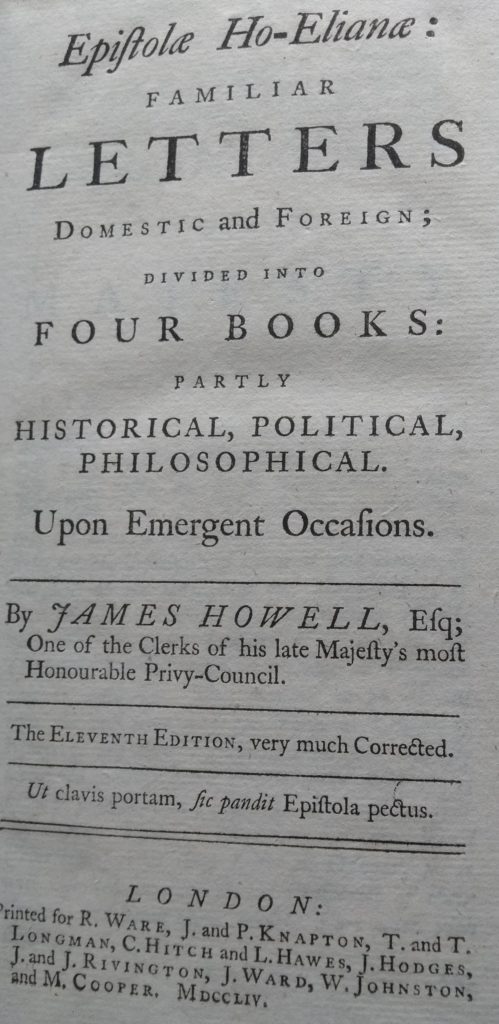
Today’s final book is a series of letters from a chap called James Howell, who had a quite a colourful life. He was an Anglo-Welsh historian, who become a clerk of the Privy Council during the Civil Wars, and was consequently unable to take up the role and instead spent some time in the Fleet Prison, where we started writing a selection of books. His bibliography includes the first epistolary novel in English, a “New English Grammar” and one of his books features the first recorded use of the phrase “all work and no play makes Jack a dull boy”! Here, we have a series of letters he wrote throughout his life to a variety of different people. It should be noted that there is some doubt over whether all of the letters he claimed to have written were actually sent as described, so take some of the following with a mild pinch of salt! I am going to share three letters, or extracts from letters, with you, shown below. The left hand one, I shall just leave for your amusement as I don’t think it needs any further description!
So the middle letter is the one alluded to at the beginning of this ‘episode’, with a most amusing description of tobacco. Apparently, “it helps Digestion, taken a-while after Meat; it makes one void Rheum, break Wind, and keeps the Body open”! Well, just marvellous indeed – who wouldn’t want to benefit from such, err, effects? I have to admit, I was somewhat baffled at first by the line about it being “a good Companion to one that converseth with dead Men” – didn’t realise that smoking was a necromantic aid… Having said this, the most incredible line of all is the one saying that “The Smoke of it is one of the wholesomest Scents”. Wow, I don’t know where we went wrong over the last four hundred or so years, but clearly we got things wrong at some point with tobacco if that’s how it used to smell!!
The right-hand letter brings back to the previous book with its description of the execution of the Marquis of Montrose in 1650. Don’t read if you are too squeamish as it goes into a fair bit of detail… I will also apologise in advance to any Scottish readers, as in my five years living up here, I have yet to see any examples of “cruelty from Scotland” so I think this is some gross slander! The latter section refers to a young Charles II, who was crowned in Scone in January 1651 under the terms of the Treaty of Breda, wherein he fully submitted to the power of the Kirk in Scotland and undertook to introduce this to England. Needless to say, he completely repudiated the treaty on being restored to the throne in 1660!
So ends the fifth ‘episode’ of the Tour of the Tops with three letters detailing some of the more unusual aspects of 17th century life! I hope that you have enjoyed this varied selection of books from the hardest to reach shelves of Innerpeffray! As the Library is now open once again, I do encourage you all to come by and visit when you can so you can perhaps explore these incredible books for yourself. The “Tours” will be taking a short break for the next month or so but will certainly be returning in October as there are plenty more shelves awaiting exploration!

